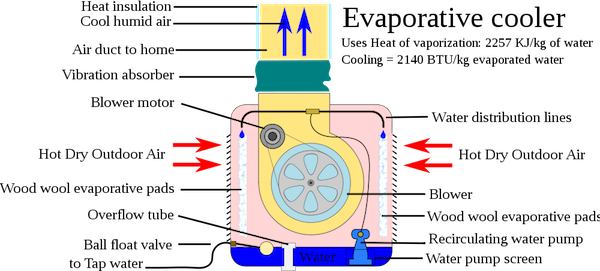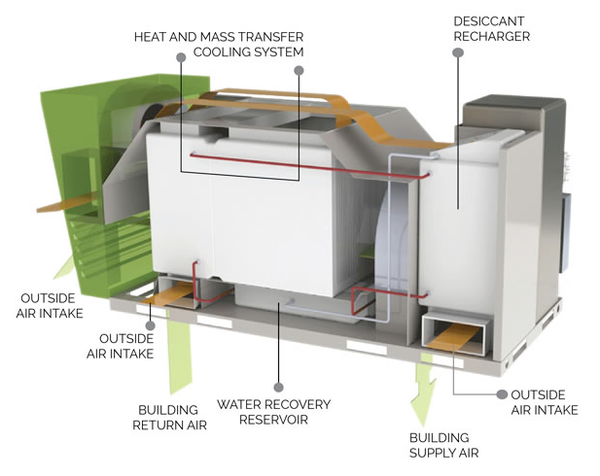This article was published in Scientific American’s former blog network and reflects the views of the author, not necessarily those of Scientific American
The energy startup scene is awash with companies claiming their new widget or software platform will fundamentally change the way we use energy. Too often, these claims come with a sizable side of hype that clouds serious limitations to real energy savings and market adoption. But every once and a while, a technology comes along that combines the right technology with the right use case to be truly transformative. Florida startup Be Power Tech’s hybrid fuel cell and air conditioner is one of those technologies.
The simplest way to describe Be Power Tech’s system is an air conditioner that runs on natural gas and produces some bonus electricity on the side. The fact that the air conditioner runs on natural gas — an energy form that can be easily and cheaply stored — alone makes it innovative. Shifting some cooling power to natural gas would substantially reduce peak summer power demand, and help to reduce the need for costly peaking power plants.
But what makes Be Power Tech’s technology truly innovative is not the fact that it produces air conditioning from natural gas, but that it does so by combining two techniques that give it a decisive advantage over conventional air conditioning and energy generation technologies: evaporative cooling and waste heat utilization.
On supporting science journalism
If you're enjoying this article, consider supporting our award-winning journalism by subscribing. By purchasing a subscription you are helping to ensure the future of impactful stories about the discoveries and ideas shaping our world today.
Evaporative Cooling for Low-Power Air Conditioning
Conventional air conditioning works by compressing a refrigerant using a high-power motor until it transforms from a gas into a liquid under high pressure. Then, the liquid refrigerant is pumped into a device called an evaporator, which essentially sucks heat out of the building as the refrigerant evaporates from a liquid back into a gas. The electricity consumed by the air conditioner is mostly for the compressor that is used to turn the evaporated refrigerant back into a liquid. The loud buzz you hear from an outdoor air conditioner is the sound of the compressor doing its work.
Rather than a conventional compressor-driven air conditioner, Be Power Tech’s system uses an innovative desiccant-enhanced evaporative cooler originally developed at the National Renewable Energy Laboratory (NREL). The company has obtained an exclusive license from NREL for use of the technology.
Like a conventional air conditioner, an evaporative cooler absorbs heat from inside a building using evaporation. However, the cooling is accomplished by evaporating water rather than a refrigerant. Hot, dry air is conditioned by pumping it over a pool of water that slowly evaporates and causes the air to become cooler and more humid as it passes through the system.

An evaporative cooler or swamp cooler sucks heat out a stream of hot, dry air by slowly evaporating a pool of water. Credit: Nevit Wikimedia(CC BY-SA 3.0)
Evaporative cooling is by no means a new technology. You can buy an evaporative cooler (also sometimes called a swamp cooler) for just a few hundred dollars. The problem is that they only work when the outside air is hot and dry. This means they can’t be used in the vast majority of the country, because the air is just too humid in the summertime.
To overcome this limitation, Be Power Tech’s cooling system uses a desiccant to suck water out of the air before it is chilled through evaporative cooling. The desiccant is a liquid salt solution that has a high affinity to absorb water from air. With the addition of the desiccant, the technology achieves all of the benefits of an evaporative cooler without the limitations that restrict conventional evaporative coolers to dry regions only.

Be Power Tech's system uses a desiccant-enhanced evaporative cooler to get all of the energy-savings benefits of evaporative cooling without the limitation of not working in humid climates. Credit: Be Power Tech
But to work properly, the system needs some way to get water out of the desiccant so that it can be continuously used to extract moisture from incoming humid air. That’s where the system’s on-board fuel cell comes in.
A Heat Source That Makes Electricity on the Side
To dry out the desiccant after it has absorbed water from the incoming humid air, Be Power Tech’s system uses the waste heat produced by a natural gas fuel cell. The heat evaporates water from the liquid desiccant and dry, “charged” desiccant is stored in a tank until it is needed.
A natural gas fuel cell converts natural gas directly into electricity through an electrochemical process that essentially strips electrons from the incoming hydrocarbon gas and turns it into a mixture of water vapor and carbon dioxide. Any fuel energy that isn’t converted into electrical energy is rejected as heat. A typical natural gas fuel cell converts about half of the incoming fuel’s chemical energy into electricity and half into heat, and operates at about 600 degrees Celsius.
Normally, natural gas fuel cells like Bloom Energy’s “energy server” operate to produce electricity for sensitive loads like this eBay data center and reject produced heat to the environment as a waste product.
Be Power Tech’s system works the other way around by using the fuel cell as a source of heat to dry out the desiccant used in the air conditioning side of the system. The electricity produced by the fuel cell is then fed to the building where it can be used for lighting, computers, and all sorts of other commercial loads. The advantage of operating in this way is that nearly all of the chemical energy contained in the natural gas fuel can be used for something useful — resulting in less energy consumption overall. According to Be Power Tech, their system uses over 80 percent of the chemical energy in the input natural gas to either make electricity or provide air conditioning.
Everyone Wants a Better Air Conditioner
Be Power Tech’s system might sound complicated, but in essence it is a drop-in replacement for a conventional rooftop commercial air conditioner that runs on natural gas and uses a lot less energy to produce the same amount of cooling. This means that building owners could see a huge reduction in energy costs from installing the system, especially with today’s low natural gas prices.
To bring its technology to market, Be Power Tech is conducting tests of the system under various atmospheric conditions and use cases in partnership with Oak Ridge National Laboratory. The company expects to begin field trials of the system next year. If they can prove the system’s benefits under real-world operating conditions and communicate its value proposition to commercial customers, I expect they will see rapid adoption of the technology. Air conditioning is a major expense for commercial building owners, and everyone wants a better air conditioner.